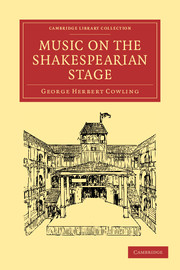Book contents
- Frontmatter
- PREFACE
- Contents
- LIST OF ILLUSTRATIONS
- Introduction
- CHAP. I Music in pre-Shakespearian drama
- CHAP. II An Elizabethan Stage and its music
- CHAP. III Musical instruments and their uses
- CHAP. IV Incidental music
- CHAP. V Musicians, Singers and Songs
- CHAP. VI Elizabethan music, and its share in the drama
- CHAP. VII Some literary allusions to music in Elizabethan plays
- Bibliography
- Appendix
- Index
CHAP. VI - Elizabethan music, and its share in the drama
Published online by Cambridge University Press: 07 September 2010
- Frontmatter
- PREFACE
- Contents
- LIST OF ILLUSTRATIONS
- Introduction
- CHAP. I Music in pre-Shakespearian drama
- CHAP. II An Elizabethan Stage and its music
- CHAP. III Musical instruments and their uses
- CHAP. IV Incidental music
- CHAP. V Musicians, Singers and Songs
- CHAP. VI Elizabethan music, and its share in the drama
- CHAP. VII Some literary allusions to music in Elizabethan plays
- Bibliography
- Appendix
- Index
Summary
If the Elizabethan age was like “a nest of singing birds,” and “the golden age of English music” as the critics tell us, how is it that the best songs are not heard at our concerts? The answer is that the songs as music, however beautiful they may be as poems, have been left far behind by later developments in harmony. The poems are still read with lively enthusiasm, and the madrigals are a living joy to some glee-societies; but the songs, the airs and the dances are forgotten; save by a few cultured musical antiquaries, who, after valuing Elizabethan music for its historical importance, have learned to appreciate its beauties.
Owing to their diatonic nature, Elizabethan airs sound like snatches of old psalm-tunes. They are all quaint, many of them are pleasing and even powerful in their emotional appeal, but, to ears accustomed only to modern music, they are uttered in a dead language which sounds often harsh and crude. The seventh note of the scale is frequently left unsharpened, which conveys to modern ears the effect of a change of key. This is owing to the fact that their scales were hexachords. Another peculiarity was that Elizabethan ears could tolerate a “false relation.” Leaps in the melody from a given note to its imperfect octave (e.g. ♯F to ♮F) are sometimes made, even in vocal music.
- Type
- Chapter
- Information
- Music on the Shakespearian Stage , pp. 89 - 98Publisher: Cambridge University PressPrint publication year: 2009First published in: 1913



